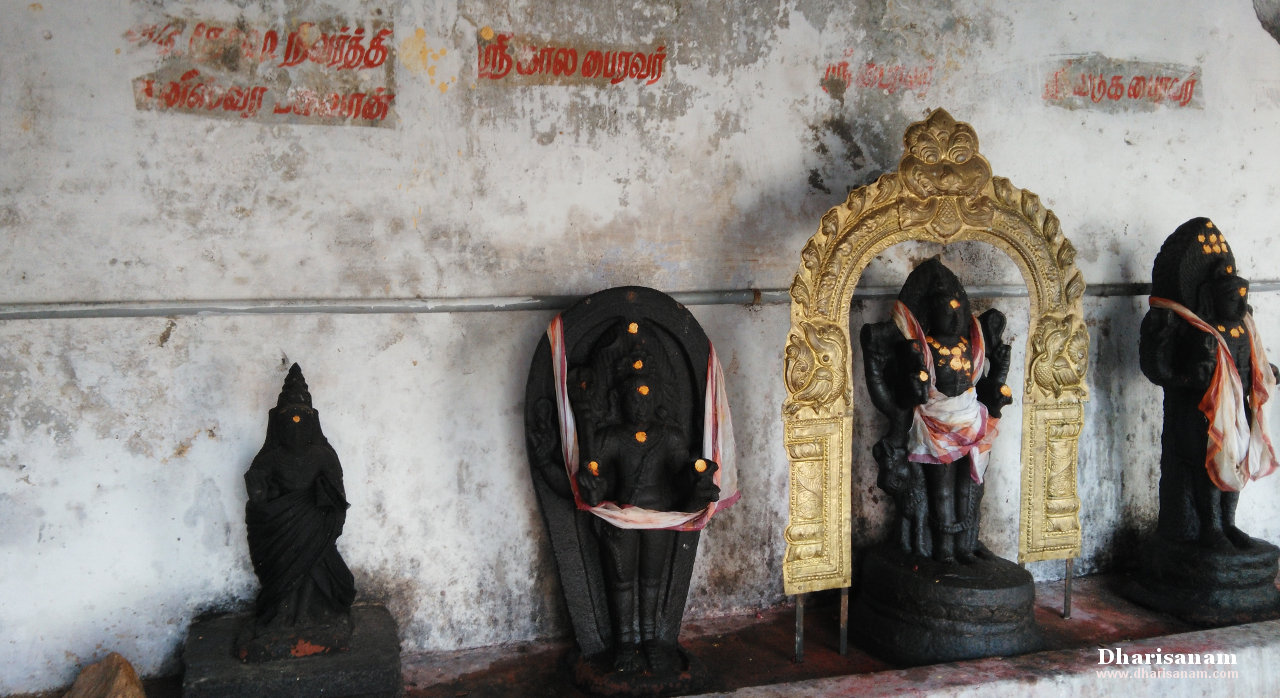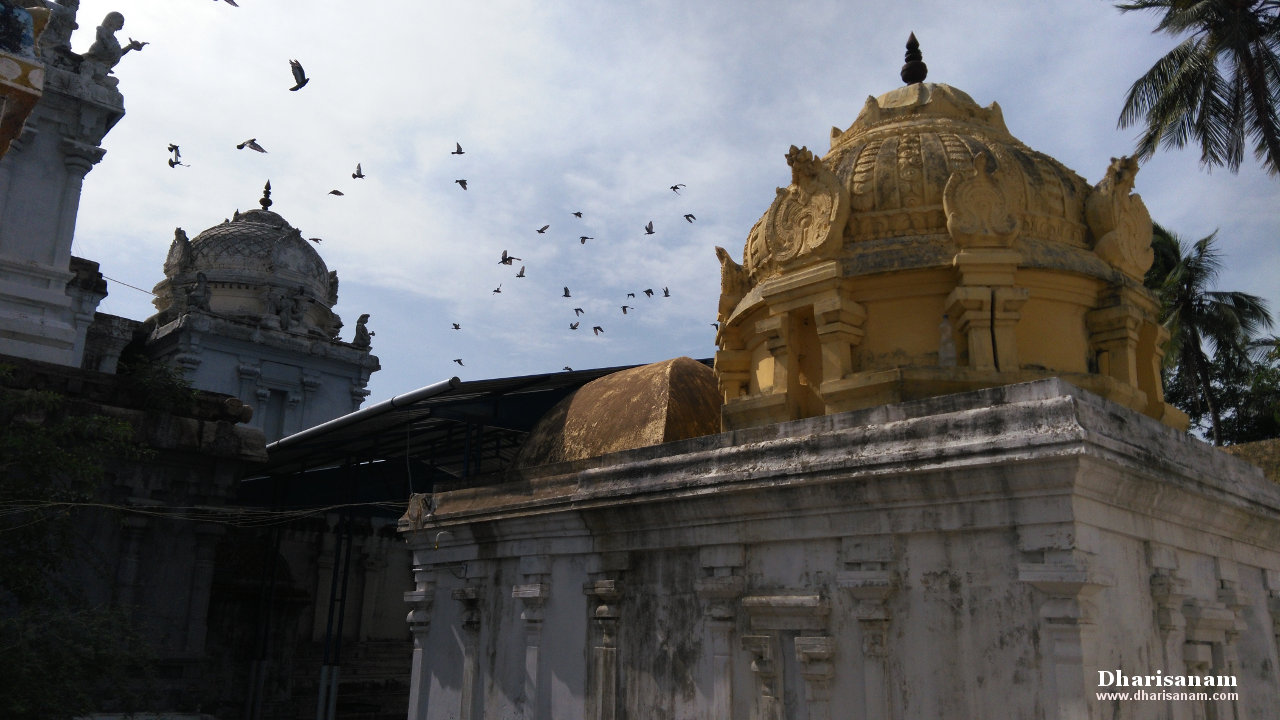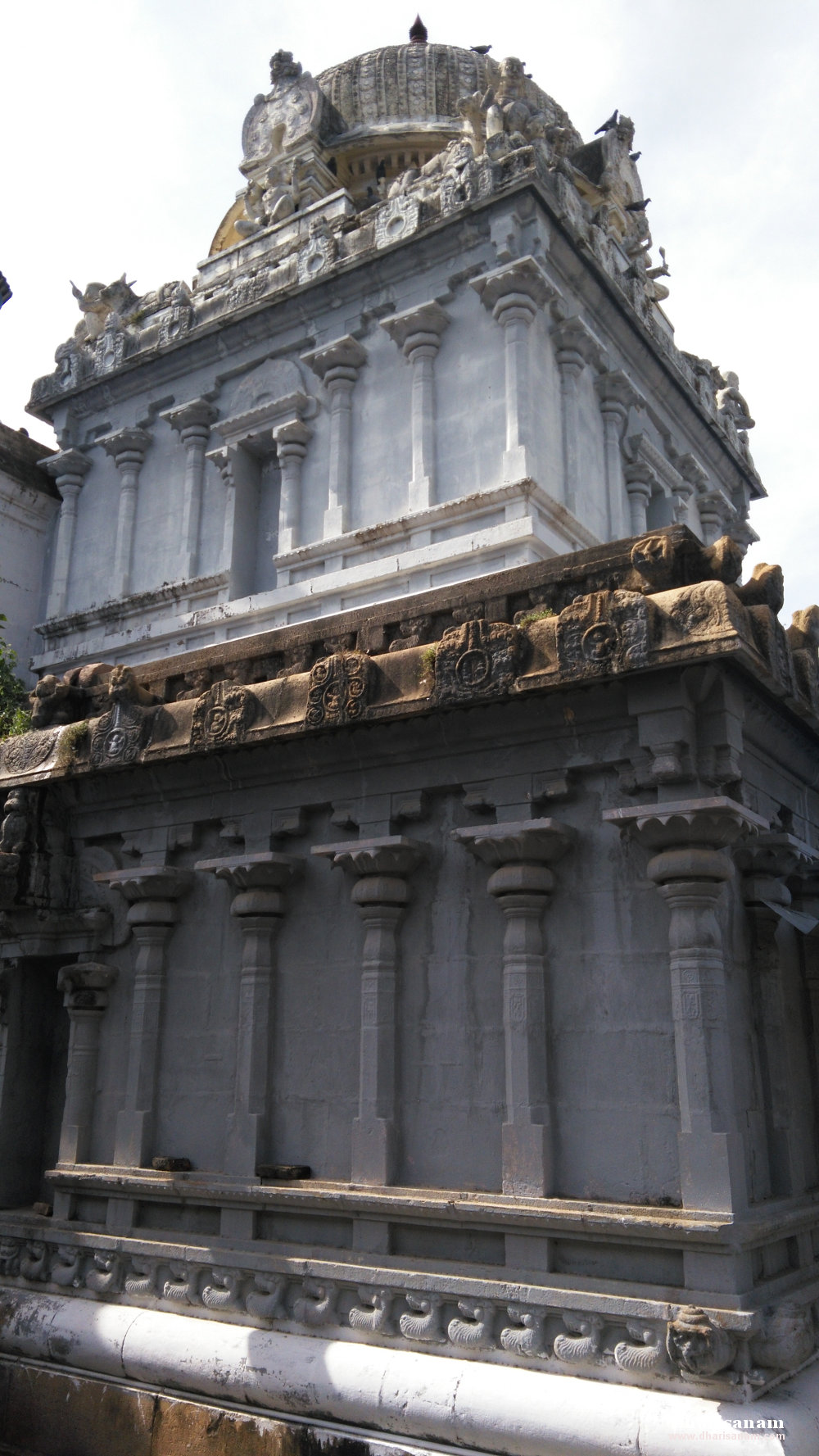Visited on: 11th June, 2018.
Location
Peruvelur (Manakkal Ayyampettai) is situated at a distance of about 8 kms from Thiruvarur on the Kumbakonam-Kudavasal-Thiruvarur route. From Kudavasal, this place is about 12 kms. From Manakkal, this place is about one kilometer away.
Other Devara Paadal Petra Shiva Sthalams near this place are –
Thalayalangadu, Karaveeram, Kaduvaikkarai Puthur, Naalur Mayanam, Thirucherai, Thirukkollamputhur, Kudavasal, Penu Perunthurai, Thiru Naraiyur Siththeecharam, Arisirkarai Puthur, Sivapuram, Karukkudi and Kalayanallur.
General Information
| Moolavar | Sri Abhi Muktheswarar, Sri Piriyaa Nathar, Sri Seshapureeswarar |
| Ambal | Sri Abinambigai, Sri Niraikonda Nayaki, Sri Elavar Kuzhali, Sri Minnanaiyalammai |
| Theertham (Holy water) | Saravana Poikai, Agni Theertham |
| Sthala Vriksham (Sacred Tree) | Vanni tree |
| Pathigam (Hymn) rendered by | Saint Thirugnanasambanthar-1, Saint Thirunavukarasar (Appar)-1 |
- This is one of the 276 Devara Paadal Petra Shiva Sthalams and 92nd Shiva Sthalam on the Southern bank of the river Cauveri in Chozha Nadu (Thenkarai).
- Lord Shiva in this temple is a Swayambumurthi (self-manifested).
- This is a “parihara sthalam” for planet Sukran.
- This is the place where “Lalitha Thirisathai” originated.
- This temple is counted as one of the Maadak Koils built by Chola King Kochenganan.
- This east facing temple has two corridors and its main tower (Rajagopuram) has 3-tiers.
- The last consecration ceremony (Maha Kumbabishekam) took place on 02.07.2006 and prior to that on 07.09.1969.
History of the Temple
It is believed that this temple is built on top of a small piece of Mount Kailash that had fallen down during a fight between Aadhisheshan and Vayu.
The historical names of this place are Katturainpettai and Kattur Iyampettai. Now it is known as Manakkal Iyampettai.
This temple is under the administrative control of the Hindu Religious and Charitable Endowments Department of Government of Tamil Nadu (HR&CE).


Legend
It is believed that Lord Murugan came to this place, created a pond and worshiped Lord Shiva. Lord Shiva blessed him with a “Vel” (a weapon). Hence this place gets the name “Velur” and the theertham is known as “Saravana Poikai” (“Saravana” refers to Lord Murugan).
It is believed that Lord Mahavishnu prayed to Lord Shiva here so that he could shed his “Mohini” form and come back to his original form. There is a separate shrine for Lord Mahavishnu with Goddesses Sreedevi and Poodevi in this temple. In this shrine, Lord Mahavishnu is seen in a sitting posture.
It is also believed that Lord Murugan, River Ganges, Sages Gowtama and Birungi and Saints Thirugnanasambanthar and Thirunavukkarasar have worshiped Lord Shiva here.
Deities in the temple
Other than the shrines of Lord Shiva and Goddess Parvathy, shrines and idols of Vinayakar, Murugan with his consorts, Natarajar, Somaskandar, Mahalakshmi, Navagraham, Saneeswarar, Suryan, Thirugnanasambanthar, Thirunavukkarasar, Sundarar, Vaikunta Narayana Perumal, Chandikeswarar and Yoga Chandikeswarar with his wife can be seen in the corridors.
There are three Bairavars in a single shrine – Kala Bairavar, Bairavar and Vaduka Bairavar. These three Bairavars are known as “Thrikala Bairavars”. Special pujas are performed to these Bairavars during “Ashtami” days.
In the “koshtam” (place surrounding the sanctum sanctorum), idols of Vinayakar, Mirukandu Maharishi, Dakshinamurthy, Lingothbavar, and Durgai can be seen.
There are six Shivalingams in the corridors - Dharmapureeswarar, Ramalingeswarar, Tharakeswarar, Saraswatheeswarar, Jambukeswarar and Ayiravadeswarar.







Salient Features
It is believed that this is the place where “Lalitha Thirisathai” originated.
Goddess Parvathy’s shrine is in the ground floor facing the east. Goddess Parvathy here is in a sitting posture (“Veerasanam”) with four hands (“Abhayavaradham”). There are only three places where Goddess Parvathy can be seen in sitting posture, the other two being Kanchepuram and Thirumeichur.
As per Sthala Puranam, once there was a mute boy who was brought by his parents to the shrine of Sri Saraswatheeswarar. They prayed to the lord and it is believed that Lord Shiva blessed the child with the gift of speech.
A beautiful banyan tree carved out of granite can be seen behind Lord Dakshinamurthy’s idol.
The idol of Vinayakar is made of white stone.
In this temple, there are three Bairavar, two Durgai and two Chandikeswarar.
Another uniqueness of this temple is that the idols of Saints Nammazhvaar, Thirumangai Aazvar and Ramanujar are placed in a row in the main hall.
The front hall (Mandapam) of this temple is designed to look like the forehead of a bat (“Vovval Nethi Mandapam”). This looks incredibly beautiful. Lord Natarajar’s shrine (“Saba”) is present in this hall.
It is believed that Chola King Kochenganan built about 70 “Madakkoils”. The distinguishing feature of a Madakkoil is that it is not easily approachable by an elephant. He built these temples at an elevation and there are a few steps that need to be climbed before seeing the lord. Also, the sanctum sanctorum’s (Karpagragam) entrance is narrow such that no elephant can enter it. In this temple, there are 18 steps to reach the sanctum.
Saint Arunagirinadhar has sung songs in praise of Lord Murugan of this temple in his revered Thirupugazh.
It is believed that the “Trinity of Carnatic music”, also known as the “three Jewels of Carnatic music” (“Sangeetha Mummoorthigal”) - Syama Sastri, Tyagarajar and Muthuswami Dikshitar have worshiped the lord here.



Greatness of this temple
This is a “parihara sthalam” for planet Sukran. Devotees with debt burden worship the lord here for relief.
Devotees believe that by worshiping the lord here, obstacles from their marriage proposals will be removed.
In this temple, Chandikeswarar is known as Yoga Chandikeswarar. He is seen along with his wife which is quite rare. It is also believed that couples who are facing problems in their relationship can worship this Chandikeswarar for relief.
Those having speech impairment (e.g. stammering) can pray to Lord Saraswatheeswar to seek relief.
Important Festivals
Some of the important festivals celebrated in this temple are –
Aadi Pooram in the Tamil month of Aadi (July-Aug),
Vinayakar Chaturthi in the Tamil month of Aavani (Aug-Sept),
Navarathri in the Tamil month of Purattasi (Sept-Oct),
Skanda Shashti and Annabishekam in the Tamil month of Aippasi (Oct–Nov),
Thiru Karthikai in the Tamil month of Karthikai (Nov-Dec),
Thiruvadhirai in the Tamil month of Markazhi (Dec-Jan),
Makara Sankranthi in the Tamil month of Thai (Jan-Feb) and
Shivrathri in the Tamil month of Masi (Feb-Mar).
Pradosham is also observed regularly.
Temple Timings
From 08:00 AM to 12:00 Noon and from 05:00 PM to 08:30 PM.
Temple Address
Sri Abhi Muktheeswarar Temple,
Peruvelur (Manakkal Ayyampettai),
Kudavasal Taluk,
Thiruvarur District,
Tamil Nadu- 610 104.
Tele: +91-4366 325425.
This temple’s priest Sri Ravi Gurukkal can be contacted at +91 - 99442 49941, 99438 60196.






Pathigam (Hymn) with English transliteration and Tamil meaning.
Saint Thirugnanasambanthar visited this temple and sang this Pathigam.
Devotees visiting this temple should make it a practice to recite this Pathigam.
Pathigam No. 3.064.
அண்ணாவுங் கழுக்குன்றும் ஆயமலையவை வாழ்வார்
விண்ணோரும் மண்ணோரும் வியந்தேத்த அருள்செய்வார்
கண்ணாவார் உலகுக்குக் கருத்தானார் புரமெரித்த
பெண்ஆணாம் பெருமானார் பெருவேளூர் பிரியாரே.
“Aṇṇāvuṅ kazhukkuṉtṟum āyamalaiyavai vāzhvār
viṇṇōrum maṇṇōrum viyanthēththa aruḷseyvār
kaṇṇāvār ulakukkuk karuththāṉār purameriththa
peṇāṇām perumāṉār peruvēḷūr piriyārē”.
சிவபெருமான் திருவண்ணாமலையும், திருக்கழுகுன்றமும் ஆகிய மலைகளில் தம்மை அடைந்தோர்க்கு வாழ்வுதரும் பொருட்டு எழுந்தருளியுள்ளார். விண்ணுலகத்தவரும், மண்ணுலகத்தவரும் வியந்து போற்ற அருள்செய்வார். உலகிற்குக் கண்ணாக விளங்குபவர். வழிபடுபவர்களின் கருத்தில் இருப்பவர். முப்புரங்களை எரித்தவர், பெண்ணும், ஆணுமாக விளங்கும் அப்பெருமான் திருப்பெருவேளூர் என்னும் திருத்தலத்தைப் பிரியாது வீற்றிருந்தருளுகின்றார்.
கருமானின் உரியுடையர் கரிகாடர் இமவானார்
மருமானார் இவரென்றும் மடவாளோ டுடனாவர்
பொருமான விடையூர்வ துடையார்வெண் பொடிப்பூசும்
பெருமானார் பிஞ்ஞகனார் பெருவேளூர் பிரியாரே.
“Karumāṉiṉ uriyuṭaiyar karikāṭar imavāṉār
marumāṉār ivareṉtṟum maṭavāḷō ṭuṭaṉāvar
porumāṉa viṭaiyūrva thuṭaiyārveṇ poṭippūsum
perumāṉār piññakaṉār peruvēḷūr piriyārē”.
சிவபெருமான் கரியமானின் தோலை ஆடையாக உடுத்தவர். சுடுகாட்டில் ஆடுபவர். இமவான் மருமகன் இவர் என்று சொல்லும்படி உமாதேவியை உடனாகக் கொண்டவர். போர்புரிய வல்ல பெருமையையுடைய இடப வாகனத்தில் ஊர்ந்து செல்பவர். திருவெண்ணீற்றினைப் பூசியவர். பிஞ்ஞகன் என்று போற்றப்படும் அச்சிவபெருமான் திருப்பெருவேளூர் என்னும் திருத்தலத்தில் வீற்றிருந்தருளும் பிரிய நாதர் ஆவார்.
குணக்குந்தென் திசைக்கண்ணுங் குடபாலும் வடபாலுங்
கணக்கென்ன அருள்செய்வார் கழிந்தோர்க்கு மொழிந்தோர்க்கும்
வணக்கஞ்செய் மனத்தராய் வணங்காதார் தமக்கென்றும்
பிணக்கஞ்செய் பெருமானார் பெருவேளூர் பிரியாரே.
“Kuṇakkuntheṉ thisaikkaṇṇuṅ kuṭapālum vaṭapāluṅ
kaṇakkeṉṉa aruḷseyvār kazhinthōrkku mozhinthōrkkum
vaṇakkañchey maṉaththarāy vaṇaṅkāthār thamakkeṉtṟum
piṇakkañchey perumāṉār peruvēḷūr piriyārē”.
சிவபெருமான் கிழக்கு, தெற்கு, மேற்கு, வடக்கு என எத்திசையிலுள்ளோர்க்கும் ஒன்றுபோல் அருள்புரிவார். அஞ்ஞானத்தால் நாள்களைக் கழிப்பவர்கட்கும், மெய்ஞ்ஞானத்தால் தம்மைப் போற்றுவார்கட்கும், மனத்தால் சிந்தித்துக் காயத்தால் தம்மை வழிபடும் அடியவர்கட்கும் அருள்புரிபவர். வணங்கிப் போற்றாதவர் கட்கு மாறுபாடாக விளங்குபவர். அப்பெருமான் திருப்பெருவேளூர் என்னும் திருத்தலத்தில் வீற்றிருந்தருளும் பிரியநாதர் ஆவார்.
இறைக்கண்ட வளையாளோ டிருகூறா யொருகூறு
மறைக்கண்டத் திறைநாவர் மதிலெய்த சிலைவலவர்
கறைக்கொண்ட மிடறுடையார் கனல்கிளருஞ் சடைமுடிமேல்
பிறைக்கொண்ட பெருமானார் பெருவேளூர் பிரியாரே.
“Iṟaikkaṇṭa vaḷaiyāḷō ṭirukūṟā yorukūṟu
maṟaikkaṇṭath thiṟaināvar mathileytha silaivalavar
kaṟaikkoṇṭa miṭaṟuṭaiyār kaṉalkiḷaruñ chaṭaimuṭimēl
piṟaikkoṇṭa perumāṉār peruvēḷūr piriyārē”.
சிவபெருமான், முன்கையில் வளையலணிந்த உமாதேவி ஒரு கூறாகவும், தாம் ஒரு கூறாகவும் இருகூறுடைய அர்த்தநாரியாய் விளங்குபவர். வேதங்களை அருளிச் செய்த நாவுடையர். மும்மதில்களை எய்த மேருமலையை வில்லாக உடையவர். நஞ்சை அடக்கியதால் கறைகொண்ட கண்டத்தர். நெருப்புப்போல் மிளிரும் சிவந்த சடையில் பிறையணிந்த பெருமானாகிய அவர் திருப்பெருவேளூர் என்னும் திருத்தலத்தில் வீற்றிருந்தருளும் பிரியநாதர் ஆவார்.
விழையாதார் விழைவார்போல் விகிர்தங்கள் பலபேசிக்
குழையாதார் குழைவார்போற் குணநல்ல பலகூறி
அழையாவும் அரற்றாவும் அடிவீழ்வார் தமக்கென்றும்
பிழையாத பெருமானார் பெருவேளூர் பிரியாரே.
“Vizhaiyāthār vizhaivārpōl vikirthaṅkaḷ palapēsik
kuzhaiyāthār kuzhaivārpōṟ kuṇanalla palakūṟi
azhaiyāvum aratṟāvum aṭivīzhvār thamakkeṉtṟum
pizhaiyātha perumāṉār peruvēḷūr piriyārē”.
உலகப் பொருள்களில் பற்றுக் கொண்டு விழையாமல் இறைவன்பால் விழைத்து பலவாறு போற்றி, உலகியலில் மருள்கொண்டு குழையாது, இறைவனின் திருவருளில் குழைந்து அவன் புகழைப் பலவாறு எடுத்துக்கூறி, “பெருமானே! அருள் புரிவீராக!” என அழைத்தும், அரற்றியும், அவன் திருவடிகளில் வீழ்ந்து வணங்குபவர்கட்கு என்றும் தவறாது உடனே அருள்புரியும் சிவபெருமான் திருப்பெருவேளூர் என்னும் திருத்தலத்தில் வீற்றிருந்தருளும் பிரியநாதர் ஆவார்.
விரித்தார்நாண் மறைப்பொருளை உமையஞ்ச விறல்வேழம்
உரித்தாராம் உரிபோர்த்து மதில்மூன்றும் ஒருகணையால்
எரித்தாராம் இமைப்பளவில் இமையோர்கள் தொழுதிறைஞ்சப்
பெருத்தாரெம் பெருமானார் பெருவேளூர் பிரியாரே.
“Viriththārnāṇ maṟaipporuḷai umaiyañcha viṟalvēzham
uriththārām uripōrththu mathilmūṉtṟum orukaṇaiyāl
eriththārām imaippaḷavil imaiyōrkaḷ thozhuthiṟaiñchap
peruththārem perumāṉār peruvēḷūr piriyārē”.
சிவபெருமான் நான்மறைகளை விரித்துப் பொருள் உரைத்தவர். உமாதேவி அஞ்சும்படி யானையின் தோலை உரித்துப் போர்த்திக் கொண்டவர். மும்மதில்களையும் ஓர் அம்பினால் இமைக்கும் அளவில் எரித்தவர். தேவர்கள் வணங்கிப் போற்ற விசுவரூபம் கொண்ட எம்பெருமான் திருப்பெருவேளூர் என்னும் திருத்தலத்தில் வீற்றிருந்தருளும் பிரியநாதர் ஆவார்.
மறப்பிலா அடிமைக்கண் மனம்வைப்பார் தமக்கெல்லாஞ்
சிறப்பிலார் மதிலெய்த சிலைவல்லார் ஒருகணையால்
இறப்பிலார் பிணியில்லார் தமக்கென்றுங் கேடிலார்
பிறப்பிலாப் பெருமானார் பெருவேளூர் பிரியாரே.
“Maṟappilā aṭimaikkaṇ maṉamvaippār thamakkellāñ
chiṟappilār mathileytha silaivallār orukaṇaiyāl
iṟappilār piṇiyillār thamakkeṉtṟuṅ kēṭilār
piṟappilāp perumāṉār peruvēḷūr piriyārē”.
இறைவர் தம்மை மறவாது தமக்கு அடியவர்களாய் விளங்குபவர்கள் மனத்தில் வீற்றிருப்பவர். சிறப்பில்லாத பகையசுரர்களின் மும்மதில்களை மேருமலையை வில்லாகக் கொண்டு, அக்கினியைக் கணையாக எய்து நெருப்புண்ணும்படி அழித்தவர். அவர் இறப்பற்றவர். நோயில்லாதவர். கேடு இல்லாதவர். பிறப்பில்லாத அப்பெருமான் திருப்பெருவேளூர் என்னும் திருத்தலத்தில் வீற்றிருந்தருளும் பிரியநாதர் ஆவார்.
எரியார்வேற் கடற்றானை யிலங்கைக்கோன் தனைவீழ
முரியார்ந்த தடந்தோள்கள் அடர்த்துகந்த முதலாளர்
வரியார்வெஞ் சிலைபிடித்து மடவாளை யொருபாகம்
பிரியாத பெருமானார் பெருவேளூர் பிரியாரே.
“Eriyārvēṟ kaṭatṟāṉai yilaṅkaikkōṉ thaṉaivīzha
muriyārntha thaṭanthōḷkaḷ aṭarththukantha muthalāḷar
variyārveñ chilaipiṭiththu maṭavāḷai yorupākam
piriyātha perumāṉār peruvēḷūr piriyārē”.
நெருப்புப் போல் சிவந்த வேற்படை உடைய சேனைகளைக் கடல்போல் விரியப் பெற்றுள்ள இராவணன் அலறுமாறு, வலிமை வாய்ந்த அவனுடைய அகன்ற தோள்களை நெரித்துப் பின்னர் அவன் சாமகானம் பாடக் கேட்டுகந்த முதல்வரான சிவபெருமான், கட்டுக்களையுடைய கொடிய வில்லேந்தி, உமாதேவியைத் தம்திருமேனியின் ஒருபாகமாகப் பிரியாது பெற்று, திருப்பெருவேளூர் என்னும் திருத்தலத்தில் வீற்றிருந்தருளும் பிரியநாதர் ஆவார்.
சேணியலும் நெடுமாலுந் திசைமுகனுஞ் செருவெய்திக்
காணியல்பை யறிவிலராய்க் கனல்வண்ணர் அடியிணைக்கீழ்
நாணியவர் தொழுதேத்த நாணாமே யருள்செய்து
பேணியஎம் பெருமானார் பெருவேளூர் பிரியாரே.
“Sēṇiyalum neṭumālun thisaimukaṉuñ cheruveythik
kāṇiyalpai yaṟivilarāyk kaṉalvaṇṇar aṭiyiṇaikkīzh
nāṇiyavar thozhuthēththa nāṇāmē yaruḷseythu
pēṇiya'em perumāṉār peruvēḷūr piriyārē”.
திருவிக்கிரமாவதாரத்தில் வானை அளந்த திருமாலும், பிரமனும் செருக்குற்றுத் தாமே தலைவர் எனக் கருதி இறைவனைத் தேட, அவனைக் காணும் முறையை அறியாதவராய், நெருப்பு வண்ணமாய் நின்ற சிவபெருமானின் திருவடிக்கீழ் நாணமுற்று நின்று தொழுது போற்ற, அவர்களின் நாணத்தைப் போக்கி அருள்செய்து பாதுகாத்த அப்பெருமான் திருப்பெருவேளூர் என்னும் திருத்தலத்தில் வீற்றிருந்தருளும் பிரியநாதர் ஆவார்.
புற்றேறி யுணங்குவார் புகையார்ந்த துகில்போர்ப்பார்
சொற்றேற வேண்டாநீர் தொழுமின்கள் சுடர்வண்ணம்
மற்றேரும் பரிமாவும் மதகளிரும் இவையொழியப்
பெற்றேறும் பெருமானார் பெருவேளூர் பிரியாரே.
“Putṟēṟi yuṇaṅkuvār pukaiyārntha thukilpōrppār
sotṟēṟa vēṇṭānīr thozhumiṉkaḷ suṭarvaṇṇam
matṟērum parimāvum mathakaḷirum ivaiyozhiyap
petṟēṟum perumāṉār peruvēḷūr piriyārē”.
புற்றேறும்படி கடுமையான தவத்தால் உடம்பை வாட்டும் சமணர்களும், மஞ்சட்காவியூட்டிய ஆடையை அணியும் புத்தர்களும் இறையுண்மையை உணராது கூறும் சொற்களை நீங்கள் ஏற்க வேண்டா. நெருப்புப் போன்று சிவந்த வண்ணமுடையவனும், தேரும், குதிரையும், யானையும் வாகனமாகக் கொள்ளாது, இடபத்தை வாகனமாகக் கொண்டுள்ள தலைவனுமான, திருப்பெருவேளூர் என்னும் திருத்தலத்தில் வீற்றிருந்தருளும் பிரியநாதனை நீவிர் தொழுது வணங்குங்கள்.
பைம்பொன்சீர் மணிவாரிப் பலவுஞ்சேர் கனியுந்தி
அம்பொன்செய் மடவரலார் அணிமல்கு பெருவேளூர்
நம்பன்றன் கழல்பரவி நவில்கின்ற மறைஞான
சம்பந்தன் தமிழ்வல்லார்க் கருவினைநோய் சாராவே.
“Paimpoṉsīr maṇivārip palavuñchēr kaṉiyunthi
ampoṉsey maṭavaralār aṇimalku peruvēḷūr
nampaṉtṟaṉ kazhalparavi navilkiṉtṟa maṟaigñāṉa
sambanthaṉ thamizhvallārk karuviṉainōy sārāvē”.
அழகிய பொன்னையும், சிறந்த மணிகளான இரத்தினங்களையும், பலவகையான கனிகளையும் அடித்துக் கொண்டுவரும் காவிரியில், பொன்னாலாகிய அழகிய ஆபரணங்களை அணிந்த, நீராடும் மகளிர்கள் மிகுந்த திருப்பெருவேளூரில் வீற்றிருக்கும் சிவபெருமானின் திருவடிகளைப் போற்றிஅருளிய வேதம்வல்ல ஞானசம்பந்தனின் இச்செந்தமிழ்ப் பதிகத்தை ஓத வல்லவர்களை அருவினைகளும், அவற்றால் வரும் பிறவிநோயும் சாரா.







